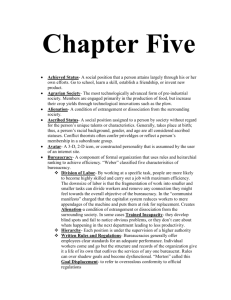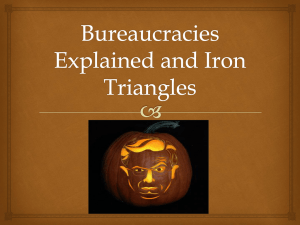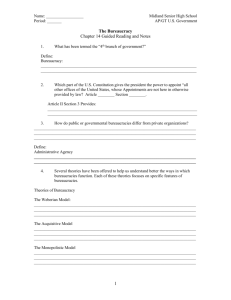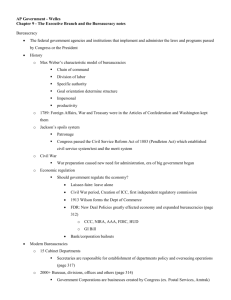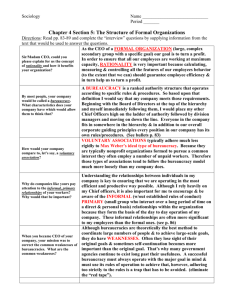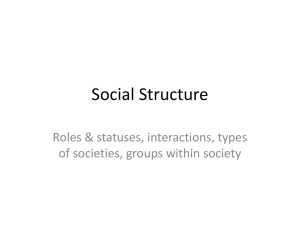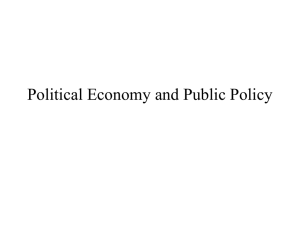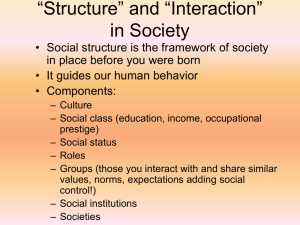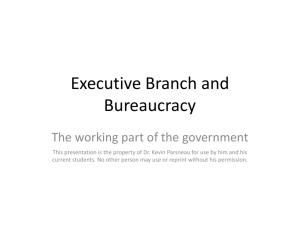File
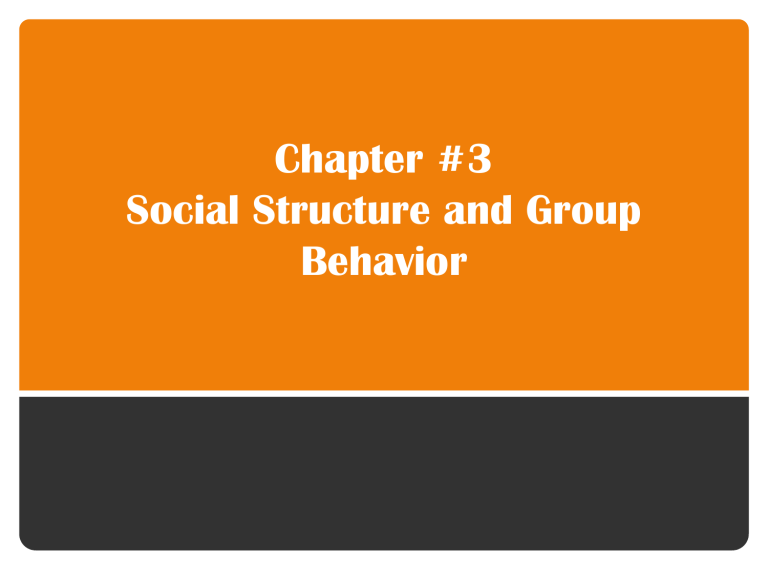
Chapter #3
Social Structure and Group
Behavior
Social Structure
Social structure refers to the way in which a society is organized into predictable relationships.
A social structure consists of a network of lasting, orderly relationships among people.
Status
Status- The manner in which sociologists describe an individual’s position within a large group or society and the relation of that person to others in the group.
Every member of a group has a status, and everyone belongs to many different groups.
Three Statuses (or stati. . .I think)
Ascribed Status- Assigned to a person by society without regard for the individual’s talents or abilities.
Achieved Status- Achieved through talents, actions, efforts, activities, and accomplishments.
Master Status- That status that plays a major role in shaping a person’s life. (Senior or age;
Soccer Player, Good Student; for adults parenthood or marital status, or even employment).
Roles
Roles- The expected behavior that a status carries with it.
We learn how to perform roles by observing and interacting with others who already understand them.
Expectations and Performance
Role expectations- Behaviors expected of someone in a particular role.
Determined by the society and are similar within a culture.
Role performance- In reality how our role expectations are carried out.
Know your roles. . . jabroni
Reciprocal roles- Roles that are part of the interaction between related statuses.
Example: You may be a student in a teacher’s class and an athlete on that coaches soccer team
Role Strain- When conflicting demands are built into a role. (School board member)
Role Conflict- When incompatible expectations arise from 2 or more statuses held by the same person. (Athlete and student)
Groups and Organizations
Group
Any number of people with similar norms, values, and expectations who regularly interact.
Groups must be small enough for members to interact regularly.
Dyads and Triads
Dyad- Simplest of all social groups, a two-member group.
A married couple (or some musical duos) are examples.
Allow for close relationships.
Group is destroyed if one member leaves.
Triad
A three member group.
Stays intact if a member leaves.
Characteristics of Groups
Structured interaction- All groups must have some type of interactions.
Examples
Group of people in a waiting room.
Office workers use of e-mail.
More characteristics of a group
Share common goals.
Example:
• Sports team that practices, works out, and cooperate with a goal of winning (I mean, we hope)
Last group characteristic
Common Identity- Members of a group share a sense of belonging that encourages a common identity.
Example: College students who left families for the first time and join a sorority or fraternity.
Sociogram
Sociogram- A diagram that shows relationship patterns among groups.
How is what’s below an example?
How do Groups Work?
Decision Making Process
How are decisions made within a group?
Group Vote (majority rules)
Leaders choose
Leadership in Groups
Most leaders are leaders because they are the best liked or have the best ideas
Normally once someone is a leader, they become one of three different types…
Authoritarian Leaders
Value efficiency and time-saving techniques
They delegate
Steve Jobs
Democratic Leaders
Like to forge an agreement within a group
Generally not as efficient as authoritarian leaders.
Laissez-faire Leaders
Hands off approach to leading.
Provides little guidance and direction.
Types of Groups
Primary Group
Face to face association with cooperation among group.
People usually identify closely with primary groups such as family, close friends or business partners.
Relationships normally last a long time.
Secondary Groups
Formal, impersonal groups in which there is little social interaction or mutual understanding.
Social relationships are generally superficial.
These groups can develop into primary groups over time.
In-Groups
Any group to which people feel they belong.
“We won the game.” or “We went on vacation.”
An in-group necessitates an out-group.
Fans of ANY sports team
Reference Group
A group that another group uses to evaluate themselves.
Play major roles in shaping opinions of ourselves.
Income and wealth are tied into this
How far your salary goes here.
Formal
Organization s
Bureaucracy. . . better yet . . . Red
Tape
Formal Organizations
When a secondary group becomes large and complex. They are often created to achieve specific goals.
Voluntary Organizations
Youth sports teams, hobby clubs and charitable organizations.
Bureaucracies
Large, hierarchical organizations.
Most large companies and modern governments are bureaucracies.
Set up to achieve specific goals
All members have assigned tasks that are narrowly defined.
Formal characteristics of a
Bureaucracy
Hierarchical chain of command
Clear division of labor (Specialized jobs)
Clearly written, well-established rules
Clearly defined set of goals
Merit-based hiring and promotion (no nepotism)
Meritocracy
Job performance is judged by productivity.
One of the first sociologist to think about the concept of bureaucracy
Thought it was a sensible way for businesses and government to meet their objectives.
Max Weber
Advantages of a bureaucracy
Best way to organize to achieve large scale goals.
Clearly define job responsibilities and goals
Organization can go on if someone leaves
The Peter Principle
In a hierarchy, every employee tends to rise to his or her level of incompetence.
This results in people working at a level that they are not competent at.
Problems with Bureaucracies
Workers lose sight of purpose due to following rituals instead of serving
One worker does not know what the next one is doing, no cross-training.
One hand doesn’t know what the other is doing
Social Interaction
Social Interaction
The way in which people respond to one another.
Symbolic Interactionists emphasize the influence that particular situations have on social behavior.
For example, when two people meet, they are constantly evaluating each other’s behavior.
Forms of Social Interaction
Exchange
Competition
Conflict
Cooperation
Accommodation
Exchange
Give and take communication
A greeting, taking turns in conversations
Relationships can be built and maintained
An uneven exchange can make one party “give up” on another
Competition
Interaction where 2 groups oppose one another
Sporting events, college scholarships, winning customers
Group unity develops when successful
Lack of cooperation can produce dis-trust
Conflict
Groups attempt to control each other by force
Fights between gangs, wars, legal disputes
Cooperation within a group during conflict can strengthen a winning group
Chaos and suffering can result from conflict.
Cooperation
Groups join forces to reach a common goal
Workers building a house, 9/11 reaction by citizens
Jobs get done, rewards are shared
Lack of personal achievement may bother some people.
Accommodation
Cooperation and conflict are balanced, negotiation develops
Worker strikes and labor negotiations
A difficult goal may be achieved and conflict ends
This can be very difficult to achieve.
Social Network
A series of social relationships that link a person to others and, as a result, indirectly to still more people.
Networking is a good example, though someone without good connections can see this as unfair.
